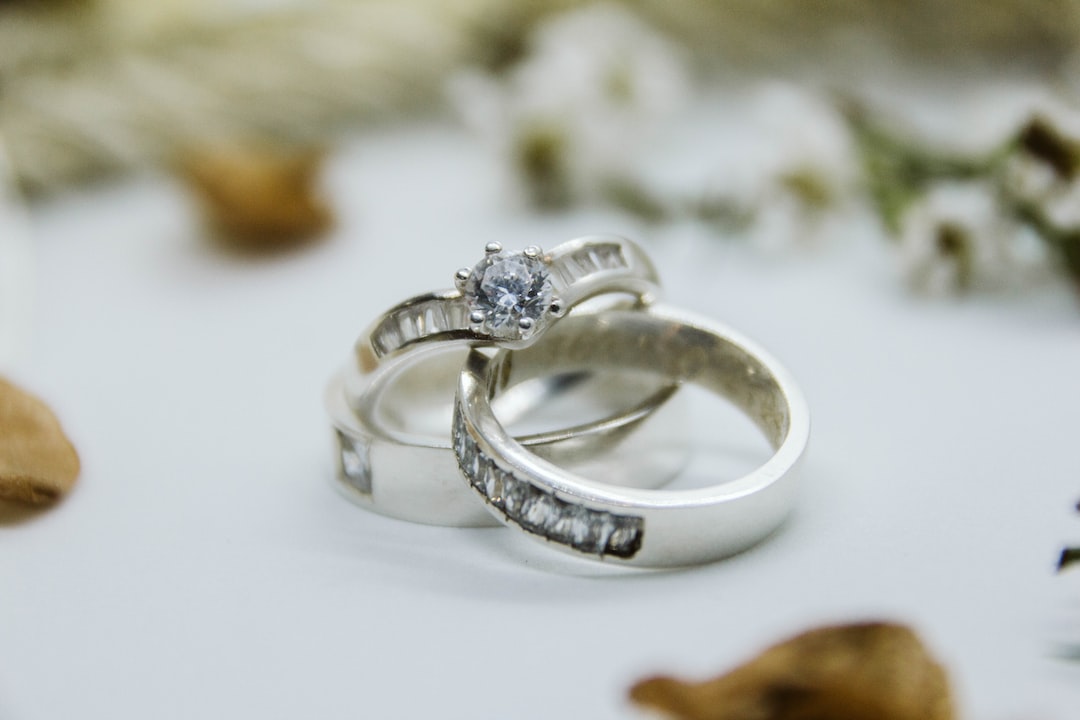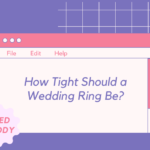When it comes to finding the perfect ring, one of the most important things to consider is size. But when it comes time to make sure your ring fits perfectly, you may be wondering if sizing a ring up or down is better for achieving that perfect fit?
It’s an important question because there are pros and cons associated with each approach – so let’s dive in and explore what factors should go into making this decision.
We’ll cover all the basics about how rings can be sized properly as well as tips for getting just the right fit when buying online.
Is It Better To Size a Ring Up Or Down?
Ring Sizing Basics
Ring sizing is the process of determining what size ring will fit your finger. This is important to ensure that you get a comfortable and secure fit for your new piece of jewelry.
What is Ring Sizing?
Ring sizing refers to the measurement of a person’s finger in order to determine which size ring will best fit them. It involves measuring the circumference, diameter, or width of a person’s finger and then comparing it against standard sizes used by jewelers. Depending on where you shop, these sizes may be expressed as numbers (e.g., 6) or letters (e.g., M). In some cases, they may also be expressed as fractions (e.g., 1/2). The goal is to find the right size so that your ring fits comfortably without being too tight or too loose when worn on your finger.
How to Measure Your Finger for a Ring
To measure your finger for a ring, wrap a flexible measuring tape around the base of your desired wearing-finger and make note of its circumference in millimeters (mm). Alternatively, you can use string or dental floss instead; just mark off where it overlaps itself with pen or pencil before laying it flat against a ruler and noting down its length in mm units. You can also measure an existing ring if you have one—just place it over an accurately calibrated ruler and take note of its inner diameter in mm units from end-to-end across its centerline..
Common Ring Sizes
In general terms, common US women’s rings range from Size 3 up through Size 10 while men’s rings usually start at Size 8 up through 13 ½+. However, this varies depending on style preferences as well as individual body types; someone with larger hands might need something bigger than average while someone with smaller hands might require something smaller than average even within their gender category. For example: A woman who typically wears small clothing could wear anywhere between 4 ½ – 5 ½+, whereas someone who typically wears large clothing could wear anywhere between 7 – 9+. Similarly for men: Someone who typically wears small clothing could wear anything between 8 – 9+, whereas someone who typically wears large clothing would likely need something closer to 11½+.
Knowing your ring size is an important part of finding the perfect fit for your wedding band. Now that you have a better understanding of the basics, let’s take a look at the pros and cons of sizing up or down.
Pros and Cons of Sizing Up or Down
Sizing up or down a ring can be an important decision when it comes to finding the perfect fit. It’s important to consider all of the pros and cons before making your final choice.
Benefits of Sizing Up a Ring: One advantage of sizing up is that you don’t have to worry about the ring being too tight on your finger, which can cause discomfort. You also won’t have to worry about losing the ring if it slips off during activities like swimming or playing sports. Additionally, sizing up may be less expensive than other resizing options since there is no need for additional materials or labor costs associated with adding metal to make the band larger.
Drawbacks of Sizing Up a Ring: The main disadvantage of sizing up is that it may not provide as secure a fit as other resizing methods, such as having extra metal added onto the band itself. This could lead to slippage and loss if you are engaging in vigorous activity while wearing your ring. In addition, some designs will look distorted when sized up due to their intricate details being stretched out over a larger surface area.
Benefits of Sizing Down a Ring: When downsizing, you get more control over how snugly your ring fits on your finger without worrying about it slipping off easily during physical activities like running or swimming. Downsizing also preserves any design elements that would otherwise be lost by stretching them out over a larger surface area when sizing up instead.
When deciding whether to size up or down, it is important to weigh the pros and cons of each option. Factors such as type of metal used in the band, design details on the band, fit preference and cost implications should all be taken into account before making a decision.
Factors to Consider When Deciding Whether to Size Up or Down
When it comes to deciding whether to size up or down a ring, there are several factors that should be taken into account.
Type of Metal Used in the Band: The type of metal used in the band can have an impact on how easy or difficult it is to resize a ring. For example, softer metals such as gold and silver are easier to work with than harder metals like titanium and stainless steel. If you’re considering resizing your ring, make sure you know what kind of metal was used so you can determine if it’s possible.
Design Details on the Band: Some rings feature intricate designs that may not be able to withstand being sized up or down without affecting their appearance. It’s important to consider any design details when deciding whether sizing is an option for your particular ring. In some cases, adding extra material during resizing may cause certain elements of the design to become distorted or less visible due to added bulkiness around them.
When selecting a new ring size, think about what kind of fit you prefer – snugger or looser. A snugger fit will stay securely on your finger while a looser one might slide off more easily but provide more comfort when wearing it for long periods of time. Ultimately, this decision comes down to personal preference and lifestyle habits; if you plan on doing activities where your hands could get wet (such as swimming), then opting for a slightly larger size might be beneficial so that water doesn’t cause discomfort by making the band too tight against your skin.
Depending on the type of metal used in the band and other factors such as its current condition (if previously worn) and complexity level (number/type of stones set within), resizing could potentially cost anywhere from $50-$200+. Be sure to ask about pricing before committing since this expense should also factor into your decision-making process when determining which route would best suit both your needs and budget constraints.
When deciding whether to size a ring up or down, it is important to consider the type of metal used in the band, any design details on the band, and your desired fit. Additionally, there are cost implications associated with sizing that should be taken into account. To ensure you get the perfect fit when buying a ring online, keep these tips in mind.
Tips for Getting the Right Fit When Buying a Ring Online
Getting the right fit when buying a ring online can be tricky. It’s important to get accurate measurements before shopping so you don’t end up with a ring that doesn’t fit or needs to be resized. Here are some tips for getting the right fit when buying a ring online:
Get Accurate Measurements Before Shopping Online: The most important step in getting the right size is making sure you have an accurate measurement of your finger. This can easily be done at home using either a paper strip, string, or ruler and measuring tape. You should also measure multiple times just to make sure you have an exact number.
Check the Return Policy Before Making Your Purchase: When ordering rings online it’s always best practice to check out the return policy first before committing to buy anything. Many retailers offer free returns and exchanges if something isn’t quite what you expected or doesn’t fit correctly, but not all do so it’s worth double checking beforehand.
Ask Questions About Resizing Options Before Buying: If you’re unsure about sizing options then it’s best to ask questions before making your purchase. Most retailers will offer advice on how their rings can be resized if needed and this information could help ensure that your new piece of jewelry fits perfectly.
Overall, taking these steps will help ensure that your new ring fits like a glove without any hassle down the line.
Making sure you get the right fit when buying a ring online is key to avoiding costly resizing fees. Fortunately, there are alternatives to traditional ring resizing methods that can help you achieve the perfect fit without breaking your budget.
Alternatives to Traditional Ring Resizing Methods
When it comes to ring sizing, traditional methods such as cutting and stretching the metal are still widely used. However, there are a few alternatives that can be employed in certain situations.
Laser Resizing: This method involves using a laser beam to cut away excess metal from the band of the ring. It is most commonly used when only a small amount of resizing is needed or when intricate details on the band make traditional methods difficult or impossible. The advantage of this method is that it does not damage any design elements on the ring and can be done quickly and accurately with minimal disruption to its structure.
Soldering Rings Together: If you need more than one size larger for your ring, soldering two rings together may be an option. This involves joining two rings side-by-side so they fit snugly around your finger without being too tight or loose. It’s important to note that this technique requires precise measurements and skillful craftsmanship in order for it to look seamless once completed.
Adding or Removing Links from Chain Rings: For chain style rings, adding or removing links may be necessary if you require more than one size larger (or smaller). In these cases, extra links can easily be added by a jeweler while ensuring that all other design elements remain intact – making this another great alternative for those who don’t want their original design compromised in any way during resizing process.
Overall, there are several alternatives available when it comes to resizing rings; each offering unique benefits depending on your specific needs and preferences.
When it comes to finding the perfect fit for your ring, traditional methods of resizing may not always be the best option. Fortunately, there are several alternatives that can help you get a comfortable and secure fit without having to go through a lengthy process.
Laser Resizing is one of the most popular alternatives to traditional ring resizing. This method uses lasers to precisely remove small amounts of metal from the inside or outside of a ring in order to make it larger or smaller. The advantage of this method is that it’s quick and easy, as well as being more precise than other methods. However, laser resizing can only be done on certain types of metals such as gold and platinum so if you have an unusual metal like titanium then this won’t be an option for you.
Soldering Rings Together is another alternative that involves joining two rings together with solder in order to create one larger size ring. This method works best when both rings are made out of similar materials such as gold or silver and they should also have similar designs so that they look good when joined together. The advantage here is that it allows you to combine two different sizes into one bigger size which could save time if you don’t want to wait for a new custom-made piece or don’t want any extra costs associated with getting something new made up just for sizing purposes.
FAQs in Relation to Is it Better to Size a Ring Up or Down
Is it better to go bigger or smaller with rings?
It ultimately depends on personal preference. Some people prefer larger rings as they can be more eye-catching and make a statement, while others may opt for smaller rings that are more subtle. It is important to consider the lifestyle of the person wearing the ring when making this decision – if someone works with their hands or leads an active lifestyle, then a smaller ring might be better suited for them. Ultimately, it comes down to what feels right and looks best for each individual couple.
Does sizing down a ring damage it?
No, sizing down a ring does not damage it. Professional jewelers use specialized tools and techniques to resize rings without causing any harm to the metal or stones. However, depending on the type of metal used in the ring, some resizing methods may be more suitable than others. For example, gold is easier to work with than platinum when it comes to resizing a ring. It’s important to consult an experienced professional before having your ring sized down as they can advise you on the best method for your particular piece of jewelry.
Should your ring be tight or loose?
When it comes to wearing a wedding ring, the best fit is one that is comfortable and secure. It should not be too tight or too loose. If your ring feels uncomfortable when you move your finger, it may be too tight and need to be adjusted by a professional jeweler. On the other hand, if your ring slides around on your finger or falls off easily, then it may be too loose and also require adjustment from a jeweler. Ultimately, finding the right fit for your wedding ring will ensure that you can wear it comfortably all day long without any issues.
Does 1 ring size make a difference?
Yes, ring size does make a difference. The size of the ring is important to ensure that it fits comfortably on the finger and looks proportional to the hand. If a ring is too small, it can be uncomfortable or even cause pain when worn for long periods of time. On the other hand, if a ring is too large, it may slip off or look disproportionate on the finger. Therefore, selecting an appropriate ring size is essential in order to have a comfortable and attractive piece of jewelry.




